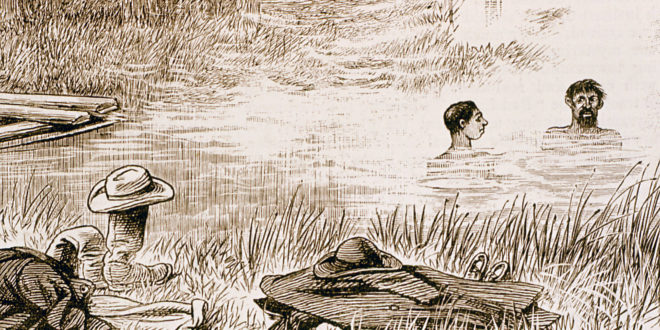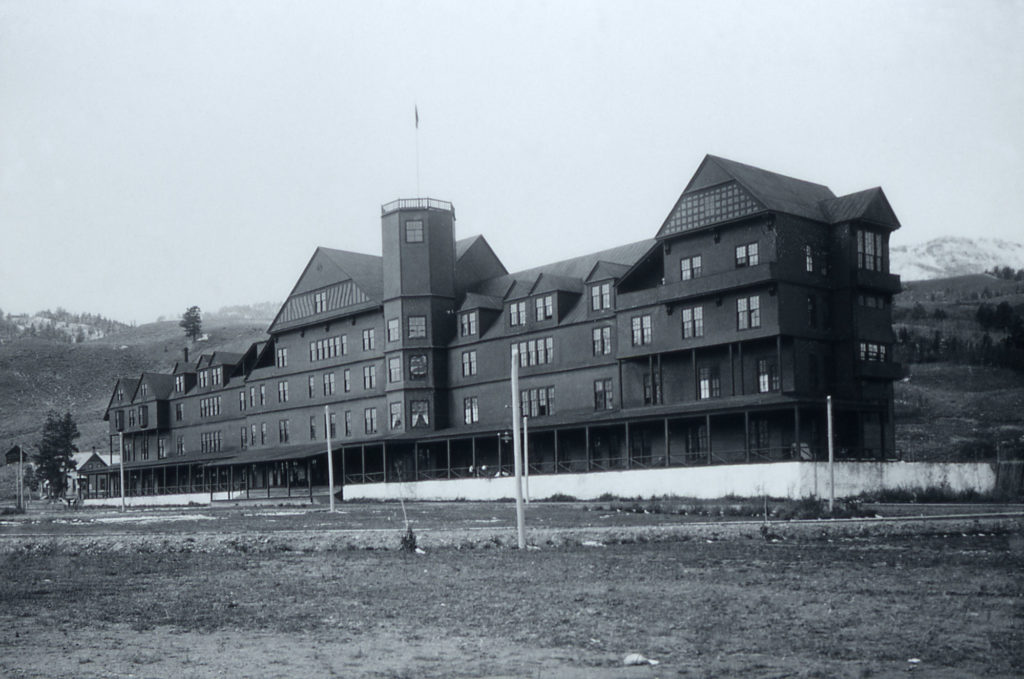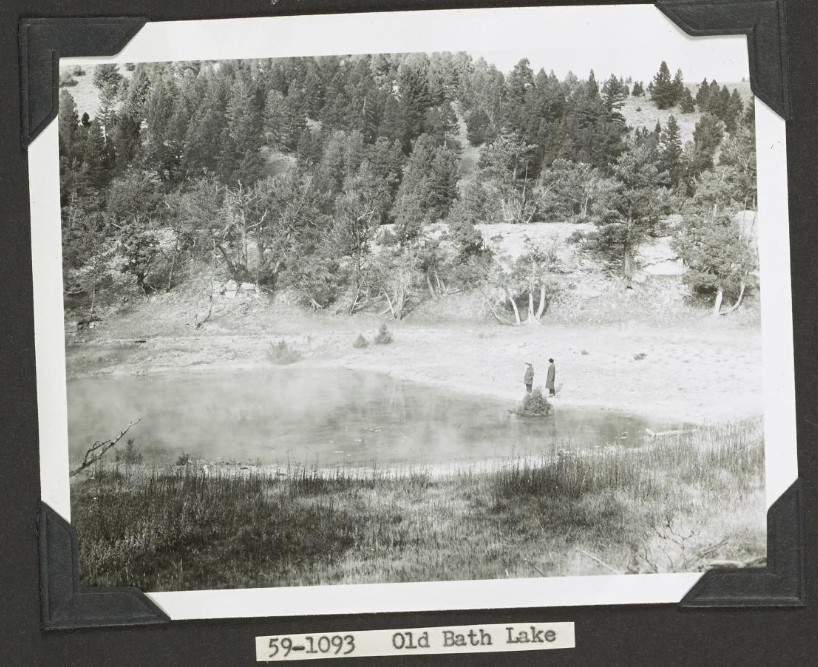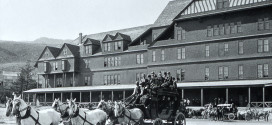Nearly a century ago, Bath Lake was one of Mammoth Hot Springs’ chief attractions.
Indeed, from its naming in the early 1880s through the 1920s, Bath Lake was nearly as famous as the Terraces and the National/Mammoth Hotel, drawing visitors of all stripes and employees of all rank.
The Name
According to Lee H. Whittlesey, writing in Yellowstone Place Names, Bath Lake likely got its name from early concessioner/tour guide G.L. Henderson in 1882 or 1883. Since the Park’s thermal waters were believed to have some medicinal quality or other, bathers flocked to features such as Bath Lake.
Today, of course, bathing is illegal in most parts of Yellowstone, especially in the thermal waters. Indeed, most of Yellowstone’s hot springs would give you a nasty burn—if you survived the initial plunge, of course.
Bath Lake (or these days, Bath Lake crater) is located several hundred feet south of Orange Spring Mound (in the early days of the Park, it was sometimes called “Orange Geyser.”) According to A.B. Guptill, writing in the 1905 Haynes Guide, when the lake was still there, “there is no visible outlet to Bath Lake; however, the uniform temperature of the water at all seasons of the year is one of the mysteries of this region.”
In all likelihood, the position and temperature of Bath Lake had everything to do with the interior plumbing of Mammoth Hot Springs. Jack Ellis Haynes, in his 1922 Guide, cautioned would-be bathers, saying “the bed of Bath Lake is rough and the rock very sharp in places.”
Welsh artist Thomas Henry Thomas, during his travels to Yellowstone in 1886, wrote of Bath Lake and even sketched it, as you can see at the top of the page. From Thomas’ recollections, as printed in Through Early Yellowstone by Janet Chapple:
Among these woods “back of” Mammoth Springs, there is a warm pool much resorted to for bathing. Repairing hither, two heads were discernible upon the reeking surface. That those cloudborne countenances were not those of a species of cherub was presumptively provided by e presence on the bank of a monumental pair of boots, having that plentitude of verge and curve which so loudly proclaims the benefit of protective duties to the American consumer, and by a wide-brimmed hat with a neat little rosette upon the band. There could be no doubt in the mind of the observer that there floated before him, in one warm baptism blent, a “rustler” of the Occident, and an Anglican priest from beyond the Eastern Ocean. It was a gracious incident, and how suggestive to the mind!
War of the Sexes
Bath Lake was especially popular with the staff of nearby National Hotel in Mammoth Hot Springs (pictured above circa 1883). George Thomas, a waiter at the National Hotel, wrote fondly of the feature in his “Recollections.” He also recounted an interesting dynamic that sprung up in relation to the pleasures of Bath Lake. Namely, how men and women divided their time in the baths. From Thomas’ “Recollections,” quoted in Yellowstone Place Names:
It was a wonderful swimming hole and had a long plank floating in the water and a swimmer could lie full length at one end of the plank and still be deep enough in the water to paddle around and be happy. One afternoon I and three other young fellows form the Hotel Waiters force, went to this lake for a swim. We had no bathing suits on, and the lake was surrounded by a growth of shrubbery that hid the water from sight, so we figures that we would not be disturbed by any passers-by. We had been in the water about an hour when we were surprised by a shower of stones that were being thrown by four young women who wanted their turn in the lake. As we were reasonable gentlemen, we left the water, grabbed our clothes and took to the brush, leaving the victorious women to enjoy their bath…
Aubrey Haines, in Volume 2 of The Yellowstone Story, cited Bath Lake as an early attraction in the Mammoth area and alluded to divided time and rock-throwing by the girls “from an adjacent hillock.” He also alluded to a time where women weren’t allowed to see Bath Lake—owing to all the male nudity. From G.L. Henderson, writing in the June 27, 1885 Livingston Enterprise, as quoted in Yellowstone Place Names:
It is to be regretted that both sexes cannot share this delightful bath. Ladies cannot even see it, for in pleasant weather a large number of nude male bathers occupy it exclusively. The government ought to regulate this matter by either constructing or permitting the construction of dressing rooms in which both sexes could have bathing suits and together “bask in the glare and stem the tepid water.”
Indeed, U.S. Cavalry Captain Moses Harris, who assumed managerial duties of the Park in 1886, briefly banned daytime bathing in Bath Lake, owing—again—to all the troublesome male nudity. Briefly, Park officials considered creating an adjacent “Ladies’ Lake” space. They even selected a suitable candidate, one “spring #33,” as named by geologist/1871 Survey alum A.C. Peale in his 1878 report to the Department of the Interior.
This never happened, of course, and eventually bathing was reopened in Bath Lake on the condition that bathers were decently attired.
“English Legation”
As one would hope, there were several amusing incidents regarding the practice of nude bathing at Bath Lake, besides the aforementioned rock throwing. Whittlesey relates one such incident involving half-a-dozen British braggarts visiting the park in 1883:
Young Julia McGowan was present at Mammoth in 1883 when President Chester A. Arthur’s party arrived along with the European VIPs in the Hatch party. She says that six sons of prominent Englishmen arrived a week or two ahead of their parents and began irritating the local cowboys with their behavior. On a lark they went for a swim in Bath Lake and looked up to see masked cowboys stealing their clothes. Left with just enough raiment to return to Mammoth Hotel, they angrily converged, almost naked, on a beleaguered desk clerk, swearing all the while that they would take the case to the highest levels of the U.S. government and the “English Legation.” The clerk calmly reached under his desk and handed their clothes back to them. Too shamefaced to “face the music,” the youths promptly disappeared (Julia Brackett to Superintendent, October 30, 1950, in box H-2, file 101, YNP Archives).
How charmingly picaresque!
The Death, Rebirth, and Redeath of Bath Lake
While Bath Lake continue to attract visitors and employees as late as 1918, the pool itself suddenly went dry in 1926. Subsequently, in 1927, it became “Old Bath Lake.” Several decades later, however, the 1959 Hebgen Lake Earthquake jarred the basin back to life, restoring its waters and its name. Alas, Bath Lake went dry in 1984—and has stayed dry ever since.
Not that you’d be allowed to bathe in it anymore.
 Yellowstone Insider Your Complete Guide to America's First National Park
Yellowstone Insider Your Complete Guide to America's First National Park








You must be logged in to post a comment.